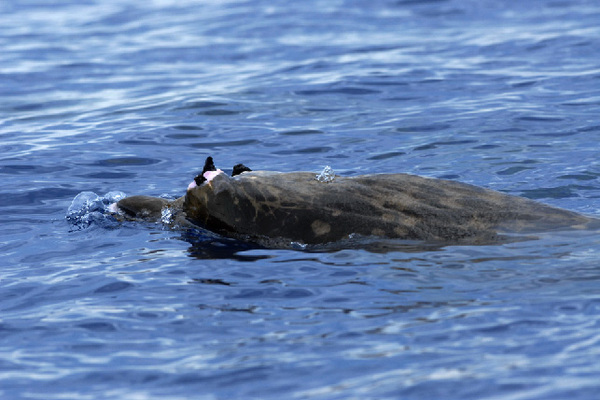
by Alexandra Ossola Thursday, January 5, 2012

Blainville's beaked whales, like all beaked whales, are sexually dimorphic - they can be easily distinguished from females and juveniles by a pair of large visible tusk-like teeth that point forward from the lower jaw. Ari Friedlaender, Duke University
In the depths of the ocean, the bizarre beaked whale looks more like an eerie mutant than a gentle giant. With its bird-like beak and sharp tusks that jut out from the top of its head, anyone would wonder: What’s with all the weaponry? Now scientists think they’ve found the purpose of these weird tusks — and it is not nearly as maleficent as you may think.
Beaked whales, a family that includes fourteen species of small-toothed whales, are some of the most enigmatic creatures on the planet. They are examples of extreme sexual dimorphism, in that only the males have large “tusks” between their mouths and eyes. Between these species of beaked whales, the tusks are different — in fact, they can be so distinctive that scientists use them as a diagnostic tool to distinguish between the species.
But with a creature as rare and elusive as the beaked whale, the purpose of these tusks has been far from easy to discover. To better understand their function, biologist Merel Dalebout of the University of New South Wales in Australia and her colleagues examined the tusks of various species of beaked whales, and how they correlated with evolutionary relationships between the species.
“We mapped different kinds of teeth onto a tree and we noticed that in closely related species that overlap in oceanic distribution, the tusks were more different,” says Scott Baker, associate director of the Marine Mammal Institute at Oregon State University in Newport, Ore., and a co-author of the study, which appeared recently in Systematic Biology. This surprised the team, he says, because, intuitively, species that are more closely related would have more in common rather than being more distinct.
Since the tusks are unique to each species, they likely have a unique use that researchers had been missing. From scars found on existing specimens, scientists have thought the tusks were used in combat, or for male-male competition as fighting tools — but that doesn’t explain their diversity, Baker says.
But based on the new evolutionary evidence, Dalebout’s team conjectures that females used the tusks to identify males of their own species from males of other species. “We think that the ornamentation is in some way used by females to identify the appropriate mate,” says Baker. In fact, the use of tusks to distinguish between species may have even driven the proliferation of new species of beaked whales.
Although this research has not explained all the mysteries of the beaked whale, it’s certainly a step in the right direction, says James Mead, a curator for the mammals department of the Smithsonian National Museum of Natural History in Washington, D.C. “Merel has come up with an interesting kind of summary of the relationship of beaked whales. We know so little about them that any paper based on actual examination of specimens is a welcome contribution.”
Tusks aside, there are still more questions than answers about one of the most mysterious mammal families on Earth — possibly including the discovery of even more species, says Baker. Since beaked whales live so far apart and are so elusive, researchers have no idea how they behave in their natural habitat, much less how they find one another in the large expanses of ocean. “We are really excited about potentially going out to see what they do in the wild. [The tusks] can’t operate at distances that these animals need to find each other, so we think they might be producing an acoustic signal.”
Mead, who was not an author on the paper, is now working with Dalebout on studying a new species of beaked whale that was discovered during this project. The team’s research has opened doors to more extensive research on the enigmatic beaked whale, Mead says. “I think what they found is good,” he says, but exactly how the beaked whales evolved “will remain open.”
© 2008-2021. All rights reserved. Any copying, redistribution or retransmission of any of the contents of this service without the expressed written permission of the American Geosciences Institute is expressly prohibited. Click here for all copyright requests.